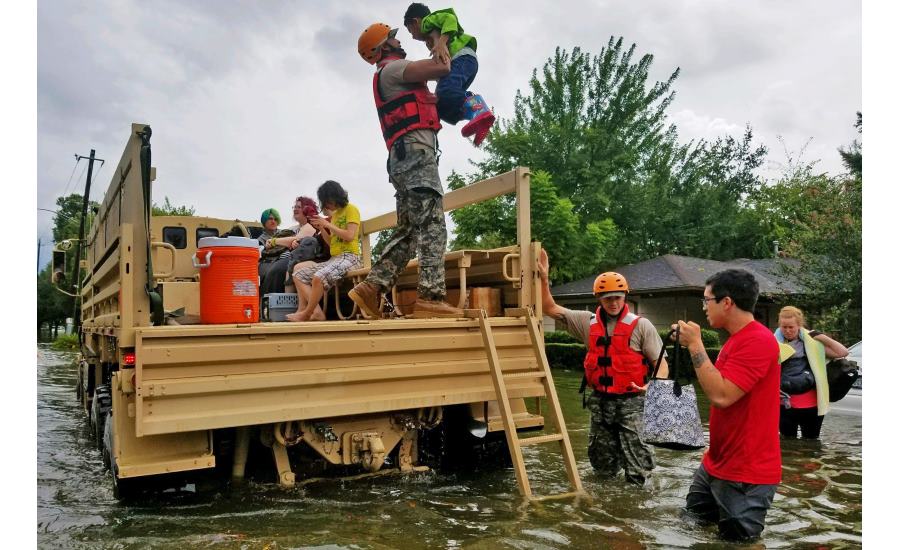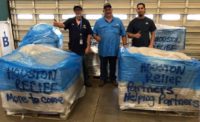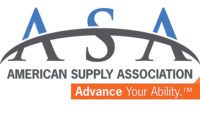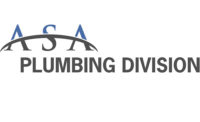At least eight people are dead and more than 2,000 have been brought to safety since Hurricane Harvey made landfall Friday in Southeast Texas. The Category 4 hurricane dumped as much as 2 feet of rain on parts of Texas, Alabama and Louisiana in just two days, causing catastrophic and widespread flooding that is only expected to worsen as rain continues to pelt the region Monday afternoon.
Meanwhile, plumbing businesses in and around Houston — which has been hit especially hard by the historic flooding — are just beginning to survey the damage to their own property, and many are still attempting to reach employees as cell phone coverage remains unreliable.
The Aftermath Of Harvey
Alicia Dover, executive director of PHCC of Texas, said the organization’s members are still assessing damages.
In a message sent to the organization’s board today, she wrote: “I have reached out to several of you as well as members that I know in and around the Gulf Coast region. Most are fine in their homes. Businesses are closed for the most part. A couple have had water damage at their shops. Jobs halted and many cannot communicate with others as cellphone coverage is spotty. Many have employees who cannot make it in. So many roads unpassable. Still waiting on status of beach homes. Many are helping with rescue effort, using their own vehicles and boats — thank you all!
“More rain is expected again today. This is huge, folks. Our thoughts and prayers go to all of you in these affected areas. The fallout will be tremendous. As for me, our son’s home survived in Victoria. No power and water at this point. No gasoline in the area. But they are dealing with just broken limbs in debris. And for that we are blessed.
“Not much to report as they are all watching and waiting. The flooding is horrendous but several members are safe. Houston covers such a large geographical area. But many still don’t know the statuses of all their employees nor their actual business locations.”
Tim Williamson, president at Service Metal out of St. Louis, a master distributor with a branch in the Houston suburbs, said they “have not been able to assess any potential damage yet, but fingers crossed.”
Christina Day, whose agency, The Company, represents Benjamin Franklin Plumbing in Houston, said the roads surrounding her home are all flooded, and many of her agency’s employees had to evacuate their homes.
“We won’t be leaving home for a few days,” she said.
Glenn Fuller, president and co-owner of Texas Plumbing Supply, PM’s 2016 Supply House of the Year winner, said they are “hanging — floating — in there.” The company has four locations in the Houston area, including two in Houston and one near Hobby Airport, which is currently closed and underwater.
“We will be back — bigger, better, stronger!” Fuller said. “[There is] no rising water in our branches. We cannot get to them because streets leading up to them are impassible. However, according to the video cameras, everything looks good. A little wind-blown rain, maybe, but [there is] no to very little damage that we can see.
“I will say, though — the rain continues now, and all the bayous, creeks and rivers are full, so areas that have not flooded will begin flooding,” he added. “We are not out of this yet.”
Milton Frank of Milton Frank Plumbing & Cooling in Spring, Texas, said they are “blessed that everyone at MFP and our family have no flooded homes,” though the floodwaters still remained high as of Monday afternoon.
“Our backyard and pool are about 3 feet underwater, but thankfully it's another 3 feet before it would reach inside our home,” Frank said. “I was able to drive to the shop this morning, and all is good there. Looks like we will be closed for several days as we wait for the water to start going down.”
He added that at least one employee has no electricity, and that he has no water, but compared to others, “we are OK.”
PHCC Activates Disaster Relief Fund
As a result of the current flooding in parts of Texas, Louisiana and Alabama, PHCC has activated its Disaster Relief Fund to provide immediate assistance to members in need.
Donations will support members whose businesses have been disrupted by major disasters now and in the future. PHCC members may use funds to offset costs to clean up flood damage, repair or replace equipment, etc.
All requests are confidential and will be considered on a first-come, first-served basis as funds become available. If you would like to donate, click here.
Convoy Of Hope Deploys Disaster Services
On Monday evening, MSCA Executive Director Barbara Dolim sent a message to members: “We at MSCA want to extend our heartfelt thoughts, prayers and support to all those affected by Hurricane Harvey, including members, MCA-affiliated chapters, suppliers, local unions and friends. We hope that all our friends at the Sales Institute, University of Houston, are safe and sound.
“Our community charity partner, Convoy of Hope, sent their Disaster Services team to Texas on Friday ahead of the storm, the first relief agency to respond. They are working with local agencies to identify the areas of greatest need.
Visit the Convoy of Hope website for more information and to donate.
Social Media Reactions
Several plumbing companies had reacted to the hurricane on social media as of Monday afternoon. Here are a few of those posts.
@AbacusPlumbing:
***Abacus Employees***
— Abacus Plumbing & AC (@AbacusPlumbing) August 28, 2017
Please reach out to communicate with your managers. You can message them right here on the... https://t.co/rp1ZlqmZ9t
@tdtplumbing_hou:
CDC’s Flood Water After a Disaster or Emergency. We're here when you need #plumbing help #Houston #HoustonFloods https://t.co/YDANfl8obl pic.twitter.com/GDtsLvTpp8
— TDT Plumbing (@tdtplumbing_hou) August 28, 2017
@JohnMooreSvcs:
We care about your family, your home, & your safety. Be cautious & careful. We'll be here to help Houstonians w the aftermath of #Harvey2017
— John Moore (@JohnMooreSvcs) August 25, 2017
@supply4plumbing:
▶ J.J. Watt says biggest thing for people is to "stay safe" as he discusses Hurricane Harvey (ESPN) https://t.co/YKjvibkDWY #Houston #Texa…
— AC Plumbing Supply (@supply4plumbing) August 28, 2017
Other plumbing companies nearby sent well wishes to those affected by Hurricane Harvey:
@GainesvillePlum:
Our Hearts go out to all those affected by the Hurricane in Texas. Here are ways you can help:#HurricaneHarvey... https://t.co/89EpA7GrXo
— Gainesville Plumbing (@GainesvillePlum) August 28, 2017
@KRKEnterprises:
Praying for those in Texas who have been affected by Hurricane Harvey, & those in Fort Myers affected by the recent flash flooding.
— KRK Pumping&Plumbing (@KRKEnterprises) August 28, 2017
@CityPlumbingTX:
Our hearts are with our fellow Texans affected by Hurricane Harvey. pic.twitter.com/oI8DzCNVAB
— City Plumbing (@CityPlumbingTX) August 28, 2017
@Marks_Plumbing_:
We would like to send our thought and prayers to everyone that has been impacted by Hurricane Harvey.
— Marks Plumbing Parts (@Marks_Plumbing_) August 28, 2017
@FlowPlumbing:
Our thoughts and prayers goes out to all the people affected by Hurricane Harvey. Stay safe.
— Flow Plumbing (@FlowPlumbing) August 27, 2017
@phccnatl:
Thoughts and Prayers out to all those affected by Hurricane Harvey. PHCC Has activated its Disaster Relief Fund. https://t.co/SaRQufwLZh
— PHCC-National Assn. (@phccnatl) August 28, 2017
Has your plumbing business been affected by Hurricane Harvey? We want to hear your story. Email anesij@bnpmedia.com.
Flood Water After A Disaster Or Emergency
The following information is courtesy of the Centers for Disease Control and Prevention.
When returning to your home after a hurricane or flood, be aware that flood water may contain sewage. Protect yourself and your family by following these steps:
Inside The Home
-
Keep children and pets out of the affected area until cleanup has been completed.
-
Wear rubber boots, rubber gloves, and goggles during cleanup of affected area.
-
Remove and discard items that cannot be washed and disinfected (such as, mattresses, carpeting, carpet padding, rugs, upholstered furniture, cosmetics, stuffed animals, baby toys, pillows, foam-rubber items, books, wall coverings, and most paper products).
-
Remove and discard drywall and insulation that has been contaminated with sewage or flood waters.
-
Thoroughly clean all hard surfaces (such as flooring, concrete, molding, wood and metal furniture, countertops, appliances, sinks, and other plumbing fixtures) with hot water and laundry or dish detergent.
-
Help the drying process by using fans, air conditioning units, and dehumidifiers.
-
After completing the cleanup, wash your hands with soap and warm water. Use water that has been boiled for 1 minute (allow the water to cool before washing your hands).
-
Or you may use water that has been disinfected for personal hygiene use (solution of ⅛ teaspoon [~0.75 milliliters] of household bleach per 1 gallon of water). Let it stand for 30 minutes. If the water is cloudy, use a solution of ¼ teaspoon (~1.5 milliliters) of household bleach per 1 gallon of water.
-
Wash all clothes worn during the cleanup in hot water and detergent. These clothes should be washed separately from uncontaminated clothes and linens.
-
Wash clothes contaminated with flood or sewage water in hot water and detergent. It is recommended that a laundromat be used for washing large quantities of clothes and linens until your onsite waste-water system has been professionally inspected and serviced.
-
Seek immediate medical attention if you become injured or ill.
See also Reentering Your Flooded Home , Mold After a Disaster , and Cleaning and Sanitizing With Bleach after an Emergency.
Outside The Home
-
Keep children and pets out of the affected area until cleanup has been completed.
-
Wear rubber boots, rubber gloves, and goggles during cleanup of affected area.
-
Have your onsite waste-water system professionally inspected and serviced if you suspect damage.
-
Wash all clothes worn during the cleanup in hot water and detergent. These clothes should be washed separately from uncontaminated clothes and linens.
-
After completing the cleanup, wash your hands with soap and warm water. Use water that has been boiled for 1 minute (allow the water to cool before washing your hands).
-
Or you may use water that has been disinfected for personal hygiene use (solution of ⅛ teaspoon [~0.75 milliliters] of household bleach per 1 gallon of water). Let it stand for 30 minutes. If the water is cloudy, use solution of ¼ teaspoon (~1.5 milliliters) of household bleach per 1 gallon of water.
-
Seek immediate medical attention if you become injured or ill.
Health Risks
Flood waters and standing waters pose various risks, including infectious diseases, chemical hazards, and injuries.
Infectious Diseases Diarrheal Diseases
Eating or drinking anything contaminated by flood water can cause diarrheal disease. To protect yourself and your family:
-
Practice good hygiene (handwashing) after contact with flood waters.
-
Do not allow children to play in flood water areas.
-
Wash children’s hands frequently (always before meals).
-
Do not allow children to play with toys that have been contaminated by flood water and have not been disinfected.
-
For information on disinfecting certain nonporous toys, visit CDC Healthy Water’s Cleaning and Sanitizing with Bleach section.
Wound Infections
Open wounds and rashes exposed to flood waters can become infected. To protect yourself and your family:
-
Avoid exposure to flood waters if you have an open wound.
-
Cover open wounds with a waterproof bandage.
-
Keep open wounds as clean as possible by washing well with soap and clean water.
-
If a wound develops redness, swelling, or drainage, seek immediate medical attention.
For more information, visit CDC’s Emergency Wound Care After a Natural Disaster.
Chemical Hazards
Be aware of potential chemical hazards during floods. Flood waters may have moved hazardous chemical containers of solvents or other industrial chemicals from their normal storage places.
Injuries Drowning
Flood water poses drowning risks for everyone, regardless of their ability to swim. Swiftly moving shallow water can be deadly, and even shallow standing water can be dangerous for small children.
Vehicles do not provide adequate protection from flood waters. They can be swept away or may stall in moving water.
Animal and Insect Bites
Flood waters can displace animals, insects, and reptiles. To protect yourself and your family, be alert and avoid contact. Protect Yourself from Animal- and Insect-Related Hazards After a Disaster
Electrical Hazards
Avoid downed power lines. Protect Yourself and Others From Electrical Hazards After a Disaster
Wounds
Flood waters may contain sharp objects, such as glass or metal fragments, that can cause injury and lead to infection. Emergency Wound Care After a Natural Disaster




